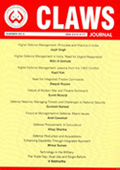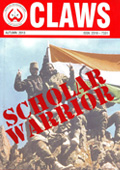| #1121 | 1084 | December 10, 2013 | By Monish Gulati | |||||
|
The government of Democratic Republic of Congo (DRC) recently claimed military victory in the eastern part of the country after the Congolese National Army (known by its French acronym FARDC) backed by the United Nations Force Intervention Brigade (FIB), handed a series of military defeats to the M23 rebel group; one of the major militias destabilising the country.{C}[i] The M23 has since announced that it is ending its insurgency and that it will disarm and demobilise. Analysts view the military end of M23 as a significant achievement and possibly the final stage of an ‘era of armed movements’ in the eastern Congo. The deployment of the FIB under United Nations Organisation Stabilisation Mission in the Democratic Republic of the Congo or MONUSCO is regarded as a “milestone redefinition” of the protection of civilians in Africa and elsewhere. FIB’s current mandate is seen to be the strongest yet, given to such a peacekeeping force. The question is whether recent success of the FIB change the way UN’s peacekeeping operations are conducted? Could the success in Congo be replicated elsewhere? What effect would it have on on going UNPKO; and on the ones that will come up in the future? Force Intervention Brigade (FIB) The UN first launched its observer mission in DRC in 1999 after rebel groups and militias began creating unrest in eastern DRC in 1994. However, last year, the U.N. mission in DRC was embarrassed after several hundred M23 rebels seized the town of Goma for 10 days, before withdrawing voluntarily. France’s foreign minister remarked that it was “absurd” that 17,000 U.N. soldiers could not protect the city and sought a review of the MONUSCO mandate. Massive demonstrations had erupted in Goma and UN vehicles were stoned. On Twitter, critics began referring to MONUSCO with the hashtag #MONUSELESS.{C}[ii] The incident prompted the UN Security Council (UNSC) to approve an intervention brigade vide its resolution 2098 (2013) this year, giving it a mandate to “neutralise” Congo’s militias. The FIB was announced on March 28, 2013 as the first-ever UN “offensive” combat force mandated to “prevent the expansion of all armed groups, neutralise these groups, and to disarm them”. Further UNSC resolution 2098 not only authorised the formation of the FIB, it also extended MONUSCO’s mandate until March 31, 2014.While resolution 2098 was not the first authorisation of lethal force, it does represent a shift from “peacekeeping to peace enforcement operations” in the region. It should also be noted that MONUSCO (and its predecessor MONUC before it) had a Chapter VII mandate, allowing it “to use all necessary means to ensure the effective protection of civilians”. However, rules of engagement and parallel chains of command from troop-contributing countries was seen to have constrained the appropriate operationalisation of this mandate. Operations in DRC Led by a Tanzanian officer, Brigadier General James Mwakibolwa, FIB is composed of 3,069 troops, organised into three infantry battalions, one artillery, and one special force and reconnaissance company. Tanzania, Malawi, and South Africa have contributed troops to the FIB.{C}[iii] During the recent operation, FIB troops were separated into three taskforces and deployed near Kiwanja, Munigi/Kibati and north-west of Rutshuru. These FIB units, supported by Mi-8s, Oryxes and Mi-26s, were intended as a blocking force to back up FARDC. The FIB concept itself is not yet free from operational voids. FIB operations over the past two months have highlighted a number of issues. Foremost amongst them is the communications problems within FIB itself and with the rest of MONUSCO, mostly due to incompatible and ineffective radio equipment.{C}[iv] Other weaknesses include aerial surveillance and air support, which are being remedied by the deployment of Falco drones in December and Rooivalk attack helicopters from South Africa. They will be backed up by five South African Air Force Oryx transport helicopters. Despite the surprisingly swift success over M23, observers have cast doubts whether the FARDC-MONUSCO coordination will get similar military success when it addresses the less centralised and structured militias. An aggressive posture of the FIB could result in an increase in violent retaliatory skirmishes. There is also the risk that political perceptions around the FIB’s decisions of which militia to tackle and in what order could be viewed as controversial. The regional make-up of the FIB could also raise suspicions of an agenda other than peacekeeping.{C}[v] Impact on UNPKO The success of the FIB in DRC has raised several issues. First, the UN through the employment of the FIB has made its support of the Congolese government forces open and in the process (according to some) moved away from the principle of neutrality that has been the guiding principle of UN missions. Second, the UN, by making itself a party to the conflict has put at risk the civilian components of MONUSCO, who may become targets of rebel reprisals in response to FIB operations. Third, humanitarian agencies are worried that Congo’s brutal militias could see all associated with the UN mission, which includes aid workers, monitors and civilian experts, as non-neutral potential targets. Fourth, it could affect the UNs’ ability to negotiate peace deals with the militias and risks deepening conflicts.{C}[vi]{C} Lastly, the UN’s total peacekeeping budget comes to $7.5 billion. More than a quarter of that is funded by the US, with Japan, France, and Germany coming next. China and Russia are in sixth and eighth places respectively. It is felt that this active posture of the UN in conflicts would create opportunities for major donors to push their own agendas in conflict zones.{C}[vii] India is the largest contributor with 4,038 personnel (including 3,732 contingent troops){C}[viii]{C} to MONUSCO’s mission strength of 21,485. Being the third largest contributor to the UNPKO (7,864 personnel as on 31 Oct 13){C}[ix] the developments in DRC as they mature could have ramifications for India including for some of its foreign policy tenets such as non-alignment. DRC and MONUSCO may prove to be a test case for India.
Monish Gulati is a Delhi based defence analyst.
Views expressed are personal [i] The M23 meanwhile is believed to have close to 2,000 combatants and is mostly made up of ex-members of the former rebel group, the National Congress for the Defence of the People (CNDP), and takes its name from the 23 March 2009 agreement reached between the CNDP and the Congolese government. The soldiers who formed the M23 rebelled against Kinshasa in July 2012 citing poor conditions and the government’s failure to properly implement the March 23 treaty. [ii] Sudarsan Raghavan. In volatile Congo, a new U.N. force with teeth, Washington Post, November 02, 2013. http://www.washingtonpost.com/world/africa/in-volatile-congo-a-new-un-force-with-teeth/2013/11/01/0cda650c-423f-11e3-b028-de922d7a3f47_story_1.html [iii] Christoph Vogel. Taking the Fight to the DRC Rebels: The Potential Pitfalls of a UN Intervention Brigade. 25 April 2013. http://thinkafricapress.com/drc/taking-fight-drc-rebels-monusco-intervention-brigade-potential-pitfalls [iv] Darren Olivier. Pincer Movements, Choppers and Teamwork: How the M23 was Pushed Back, October 30, 2013 http://thinkafricapress.com/drc/pincer-movements-choppers-and-teamwork-how-m23-was-pushed-back [v] Christoph Vogel. Taking the Fight to the DRC Rebels: The Potential Pitfalls of a UN Intervention Brigade, April 25, 2013. http://thinkafricapress.com/drc/taking-fight-drc-rebels-monusco-intervention-brigade-potential-pitfalls [vi] Ser 2. [vii] The changing role of U.N. forces? Global Public Square, November 11, 2013. http://globalpublicsquare.blogs.cnn.com/2013/11/11/the-changing-role-of-u-n-forces/#more-27931 [viii] http://www.un.org/en/peacekeeping/contributors/2013/oct13_3.pdf [ix] http://www.un.org/en/peacekeeping/contributors/2013/oct13_2.pdf | ||||||||
| ||||||||

|
Monish Gulati |


